In Aggro Autumn, I made a beatdown-oriented FNMish deck per guild in Return to Ravnica. Though I don’t offer aggressive strategies this time, I think each guild has plenty interesting to explore for Friday Night Magic or casual. (It’s always better to experiment with cards in off formats than not working with them at all.) For what it’s worth, one of my proposed decks from Aggro Autumn turned into an FNM-winning deck for me over the past month; I’ll post it at the end. But for now, let’s get into Gatecrash.
My main guideline for a posted deck is that I don’t want a single card costing over $5. It’s easier to spend than scrimp on a deck, so I’d rather build on the cheap and let you expensivify it. (I use all of the real words.)
Here goes . . .
Orzhov
Orzhov Oversize
- Creatures (20)
- 4 Syndic of Tithes
- 4 Mikaeus, the Lunarch
- 4 Galvanic Juggernaut
- 4 Desecration Demon
- 4 Alms Beast
- Spells (16)
- 4 Lingering Souls
- 4 Essence Harvest
- 4 Tragic Slip
- 4 Victim of Night
- Lands (24)
- 12 Swamp
- 8 Plains
- 4 Orzhov Guildgate
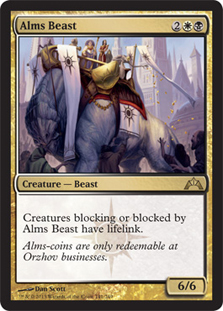 Galvanic Juggernaut, Desecration Demon, and Alms Beast provide an unusual confluence of large 4-drops. Each of them is flawed but partially mitigates each other’s drawbacks. If the opponent leaves up a creature to block Alms Beast, the Desecration Demon swings; if that creature is sacrificed to Desecration Demon instead, Galvanic Juggernaut untaps and Alms Beast has a clearer, less lifelinky path. To keep one down is to enable the others, and with all of them at a reasonable casting cost, you can rain beef on the board (probably unsanitary).
Galvanic Juggernaut, Desecration Demon, and Alms Beast provide an unusual confluence of large 4-drops. Each of them is flawed but partially mitigates each other’s drawbacks. If the opponent leaves up a creature to block Alms Beast, the Desecration Demon swings; if that creature is sacrificed to Desecration Demon instead, Galvanic Juggernaut untaps and Alms Beast has a clearer, less lifelinky path. To keep one down is to enable the others, and with all of them at a reasonable casting cost, you can rain beef on the board (probably unsanitary).
This semi-unreliable troika makes Essence Harvest reliable as a finisher. Yes, your big creatures sometimes miss attacks, but they need fewer attacks with Essence Harvest around. Mikaeus, the Lunarch can grow a fatty and therefore an Essence Harvest. Mikaeus also can pump the smaller end of your team (Syndic of Tithes and Lingering Souls) while eventually dying to untap Galvanic Juggernaut.
Syndic of Tithes is here for a few reasons. Syndic plus Mikaeus or removal is early pressure, and any extort in the first few turns takes pressure off the midgame. Since the deck tops out at 4, extortion should come easily, providing miniature Essence Harvests. Lingering Souls is two chances at extort and four creatures for Mikaeus, but its main use is blocking for Galvanic Juggernaut’s or Tragic Slip’s sake.
I suspect Gatecrash’s adding of dual lands means more prominent multicolored creatures. That should push Vampires, Werewolves, and Zombies to the background, in which case Victim of Night is better than Ultimate Price. Either one makes sense at different times. The point is having sufficient cheap removal to force tougher Desecration Demon/Alms Beast decisions.
The Orzhov might be known for nickel-and-diming, but you can lay full dollars with this deck, assuming that is a sentence that makes any sense. (The jury’s out.) This deck should work about as well in Two-Headed Giant as in duels. Desecration Demon suffers, but extort and Galvanic Juggernaut improve.
Dimir
I’ve Been Exspectering You, Mr. Bond
- Creatures (20)
- 4 Vampire Interloper
- 4 Welkin Tern
- 4 Nightveil Specter
- 4 Harbor Bandit
- 4 Dungeon Geists
- Spells (16)
- 4 Hands of Binding
- 4 Call of the Nightwing
- 4 Soul Ransom
- 4 Dimir Charm
- Lands (24)
- 12 Island
- 8 Swamp
- 4 Dimir Guildgate
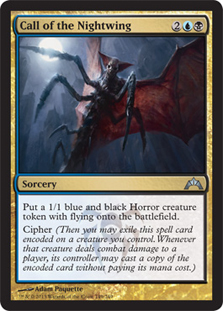 This deck does two things well: swing evasively and tap creatures. That might not be enough, but it’s worth trying.
This deck does two things well: swing evasively and tap creatures. That might not be enough, but it’s worth trying.
The earlier the flyer, the sooner you can encode. Vampire Interloper and Welkin Tern are as fast as it gets for a nontrivial flyer. Harbor Bandit is slower, but tougher. Dungeon Geists and Hands of Binding handle the biggest creatures, while Dimir Charm addresses the smaller ones and assorted tasks.
Nightveil Specter is cheaper than most recent effects of its ilk (compare Fiend of the Shadows), its hybrid cost assures casting on turn three, and it lets you play any lands you exile with it, which lets you eventually cast opponent’s spells outside your colors. Hands of Binding and Call of the Nightwing might not be the most exciting cipher spells, but I think they’re the best at preventing the backswing.
The card that most excites me here is Soul Ransom. If there’s a creature in the way of your encoded creature, take it. How your opponent addresses Soul Ransom is less important if you got value from eliminating a blocker. You’re unlikely to get a good swing with something you Ransom—the opponent can prevent its combat damage by sacrificing the creature—but it’s great as a tempo play. I suspect, absent a Thragtusk to wait for, that it’s correct to play Soul Ransom on the first average-to-good creature. If the opponent gives you the card-draw, fine.
This deck’s main enemy is Restoration Angel, but other than that, it should do its job mostly uninterrupted. You might prefer a Favorable Winds or Invisible Stalker/Dimir Keyrune build, but I like the idea of evasive tempo that steals and casts your opponent’s stuff, tapping what it can’t use. Whatever deck is the right build for this seems fun.
Gruul
Meat and Eggs
- Creatures (24)
- 4 Arbor Elf
- 4 Skarrg Guildmage
- 4 Primal Huntbeast
- 4 Slaughterhorn
- 4 Ghor-Clan Rampager
- 4 Rubblehulk
- Spells (12)
- 4 Revive
- 4 Gruul Keyrune
- 4 Clan Defiance
- Lands (24)
- 13 Forest
- 8 Mountain
- 3 Kessig Wolf Run
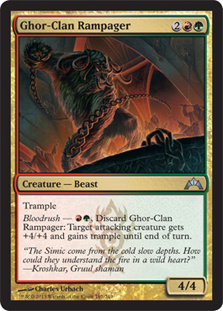 What does bloodrush look like for Constructed? I assume it involves hard-to-kill tramply things. It’s a Timmy dream—swing as hard as possible as early as possible—with what we hope are enough insurance policies to make it a reality. If the Dimir deck’s more of a machine gun with its constant fire, this is the bazooka firing a few trample blasts.
What does bloodrush look like for Constructed? I assume it involves hard-to-kill tramply things. It’s a Timmy dream—swing as hard as possible as early as possible—with what we hope are enough insurance policies to make it a reality. If the Dimir deck’s more of a machine gun with its constant fire, this is the bazooka firing a few trample blasts.
With bloodrush topping out at 3 mana here, the deck doesn’t need loads of mana to win. It wants more for Clan Defiance and Kessig Wolf Run, so Arbor Elf and Gruul Keyrune help out. But all it needs is bloodrush and an attacker. If that’s a land from Skarrg Guildmage, the hard-to-target Gruul Keyrune, or the impossible-to-target Primal Huntbeast, so much the better.
The Guildmage’s trample ability is crucial. When Ghor-Clan Rampager isn’t the creature you’re bloodrushing with, you need outside trample, and the Guildmage’s ![]()
![]() is a small price. Revive generally is re-bloodrush, although it can obtain any spell that isn’t Gruul Keyrune. That’s probably recurring Ghor-Clan Rampager early and Rubblehulk or Clan Defiance late. Maybe four isn’t the right number, but Revive mitigates the drawbacks of going all-in while refueling your attackers.
is a small price. Revive generally is re-bloodrush, although it can obtain any spell that isn’t Gruul Keyrune. That’s probably recurring Ghor-Clan Rampager early and Rubblehulk or Clan Defiance late. Maybe four isn’t the right number, but Revive mitigates the drawbacks of going all-in while refueling your attackers.
Even a turn-one Arbor Elf threatens serious damage with bloodrush. As improbable as this is, an opening hand of Forest, Mountain, Arbor Elf, and four Ghor-Clan Rampagers threatens a turn-five kill, all of it in trample. Fun by me.
Boros
Three Men and an Angel
- Creatures (24)
- 4 Boros Elite
- 4 Azorius Arrester
- 4 Lightning Mauler
- 4 Kessig Malcontents
- 4 Firemane Avenger
- 4 Riders of Gavony
- Spells (13)
- 4 Gather the Townsfolk
- 4 Boros Charm
- 2 Five-Alarm Fire
- 3 Brimstone Volley
- Lands (23)
- 11 Plains
- 9 Mountain
- 3 Boros Guildgate
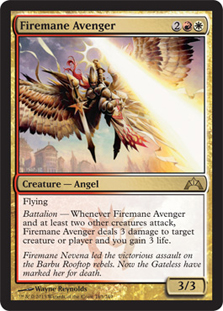 There are only three Guildgates because I’m worried about too many tapped lands with an aggressive deck.
There are only three Guildgates because I’m worried about too many tapped lands with an aggressive deck.
This deck is the most malleable of the article. Frontline Medic, Champion of the Parish, Hellrider (who was too pricey to make the deck), Nearheath Pilgrim, Rally the Peasants, and Burning Oil are all possibilities. The Boros are mostly made of Humans, and R/W Humans is already kind of a deck (though not one I know how to build). In this version, the focus is battalion plus direct damage.
Boros Elite and Firemane Avenger are the battalion creatures. Boros Elite will turn on pretty quickly, and Firemane Avenger clears the way for your other attackers. Lightning Mauler wants to make Firemane Avenger a super-Hellrider on turn four, but it’s also fine with Riders of Gavony (as Boros Charm and Frontline Medic can be: insurance when milking battalion from small creatures). Gather the Townsfolk isn’t my favorite, but it enables battalion and Kessig Malcontents quickly. Azorius Arrester is depth for Riders of Gavony while being an on-curve Human.
Boros Charm looks reasonable in all its modes here, but it’s probably most exciting as a finisher. Turn-five Kessig Malcontents plus Boros Charm can cut a life total out of nowhere. Brimstone Volley is good in any deck in which creatures die and/or you want to punish blockers; no qualification problems here. Five-Alarm Fire has a cool name (or a hot name?), but it’s also surprisingly versatile. The counters accrue on any combat damage your creatures deal—blocked or not, the fire is starting. Even better, as my friend Alex noted, the counters accrue regardless of whether the creature attacked or blocked. If you have to, you can play defensively with Five-Alarm Fire and dare the opponent to attack.
This deck attacks the face and then burns the face. If that’s what you like RE: faces, consider this deck’s two-pronged face attack. I’ll even let you change the deck name from a Ted Danson reference if you like.
Simic
Instant Oozemeal
- Creatures (20)
- 4 Cloudfin Raptor
- 4 Ambush Viper
- 4 Mayor of Avabruck
- 4 Wolfir Avenger
- 4 Wolfir Silverheart
- Spells (16)
- 4 Rapid Hybridization
- 4 Dissipate
- 4 Cancel
- 4 Mystic Genesis
- Lands (24)
- 10 Forest
- 10 Island
- 4 Simic Guildgate
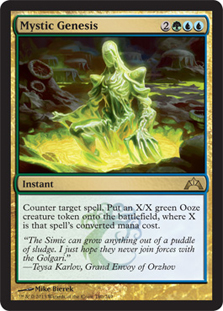 I’m a sucker for building G/U control whenever it’s remotely possible, and I think Mystic Genesis and Rapid Hybridization make it remotely possible. Draining Whelk’s been a player in a few decks, and Mystic Genesis is a mana cheaper for a similar effect. Combine counterspells with flash creatures, and there might be a deck.
I’m a sucker for building G/U control whenever it’s remotely possible, and I think Mystic Genesis and Rapid Hybridization make it remotely possible. Draining Whelk’s been a player in a few decks, and Mystic Genesis is a mana cheaper for a similar effect. Combine counterspells with flash creatures, and there might be a deck.
There weren’t enough instants for Delver of Secrets, so Cloudfin Raptor seemed the best pre-counterspell threat. Ambush Viper has long been a friend of Werewolf transform triggers. Mayor of Avabruck’s tokens can evolve Cloudfin Raptor reliably while pumping the other flash in the deck (Wolfir Avenger) and Wolfir Silverheart. The Silverheart is the big control finisher here; thanks to evolve, it’s likely to give a Cloudfin Raptor +5/+5. It also works as a follow-up to a Mystic Genesis Ooze.
The counterspell package is obvious, as is Rapid Hybridization (to which Ambush Viper plays backup), but it does extra work here synergizing with the flash creatures. It’s not quite the draw-go of old, wherein if the opponent was afraid of counterspells, you’d draw cards on the end step, but you’re playing creatures when you’re not countering spells, which might be close.
Bonus Deck: Morbid Aggro
In Aggro Autumn, I noted that the Golgari deck had the most potential but the worst build. Turns out I probably was right. I 5–0’d FNM a couple weeks ago with the following:
Morbid Aggro
- Creatures (25)
- 4 Strangleroot Geist
- 4 Dreg Mangler
- 4 Vampire Nighthawk
- 3 Ulvenwald Bear
- 3 Desecration Demon
- 3 Disciple of Bolas
- 4 Wolfir Silverheart
- Spells (12)
- 4 Rancor
- 4 Ultimate Price
- 3 Tragic Slip
- 1 Abrupt Decay
- Lands (23)
- 15 basic lands
- 4 Woodland Cemetery
- 3 Overgrown Tomb
- 1 Golgari Guildgate
This deck keys off haste (Strangleroot Geist and Dreg Mangler) and pseudo-haste (Rancor and Wolfir Silverheart). I’ve seen many an opponent have no clue what the combat math is when I have cards in hand.
The morbid package messes with combat further. Tragic Slip and Ulvenwald Bear can punish an ill-considered block. Nobody expects the Bear, but it can be a 4/4 for 3 or (as I prefer) a 2/2 that makes Vampire Nighthawk a 4/5. A lot of this deck wants to pump Vampire Nighthawk, from the Bear to Rancor to Wolfir Silverheart.
I keep mentioning Desecration Demon in recent articles, but that’s because I keep winning with it. Fiddly decks aren’t ready for a curve of Strangleroot Geist, Dreg Mangler, and Desecration Demon. The Rancored haste does enough early damage to the point that the Demon represents a too-quick clock—especially if it also suits up with a Rancor.
But it’s Disciple of Bolas that ties this together. It turns Rancors into Divinations with buyback; it turns Strangleroot Geists into Divinations with +1/+1 counters; it turns anything with Wolfir Silverheart into a full hand. It also gives Desecration Demon a use when it looks as though it won’t be swinging (e.g. Lingering Souls decks). Against a mono-red deck last tournament, I played a Desecration Demon on turn four or five. I put a Rancor on it next turn and moved to combat; my opponent sacrificed to tap the Demon into a 9/6. Post-combat, I cashed the Demon into Disciple of Bolas for nine cards and 9 life. Bant decks are delighted to cast Sphinx's Revelation for 9 in the late-game; I can mirror the effect midgame. If I have spare mana off the play, I’ve enabled morbid for Tragic Slip should I draw it.
I don’t think this deck will survive Gatecrash’s innovations. But it’s been a blast to play, as I have a different set of plays than most midrange decks do. With the haste, I’m sort of a fast midrange deck (or a beefy aggro deck?), which is as sweet as it sounds.
Conclusion
More than in Return to Ravnica, the new mechanics are hard to evaluate. Battalion’s power level is pretty easy to ascertain, but the others need experimentation in every format to find out how they play. These are my starting points for playing in the waters of Gatecrash. If you have some awesome ideas, share them in the comments. I want to know what’s good, and together, we can figure it out.


























